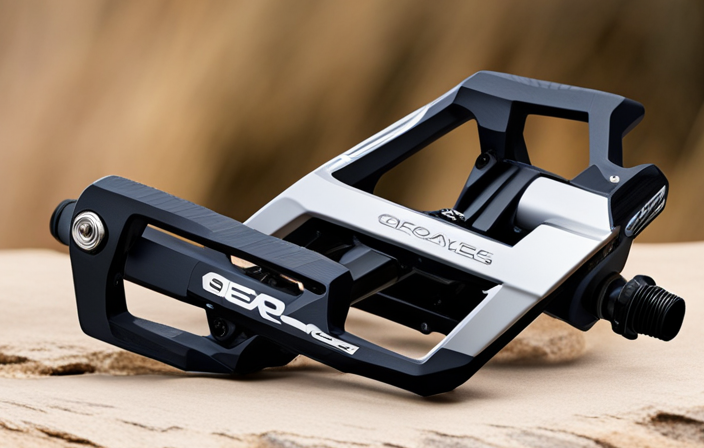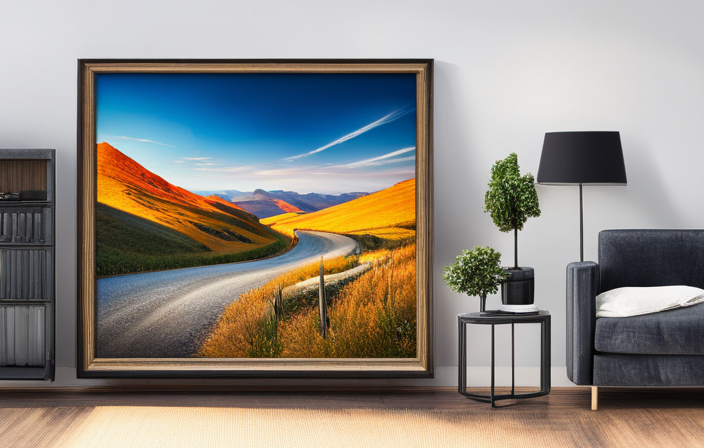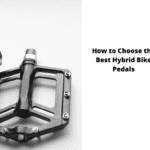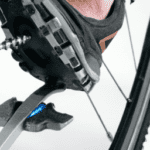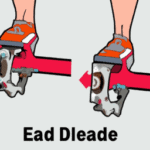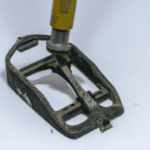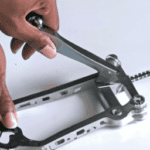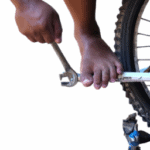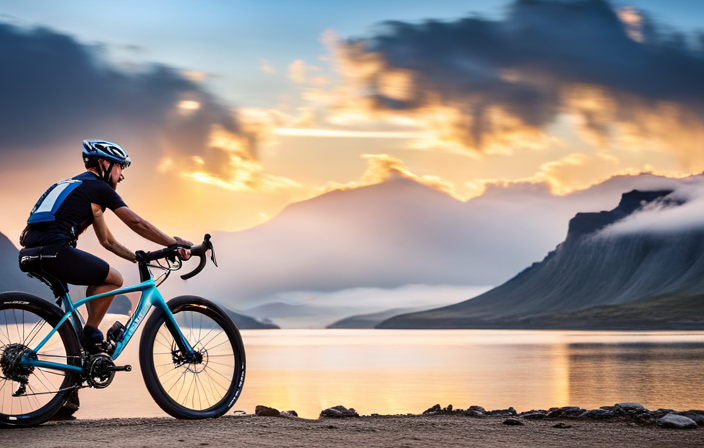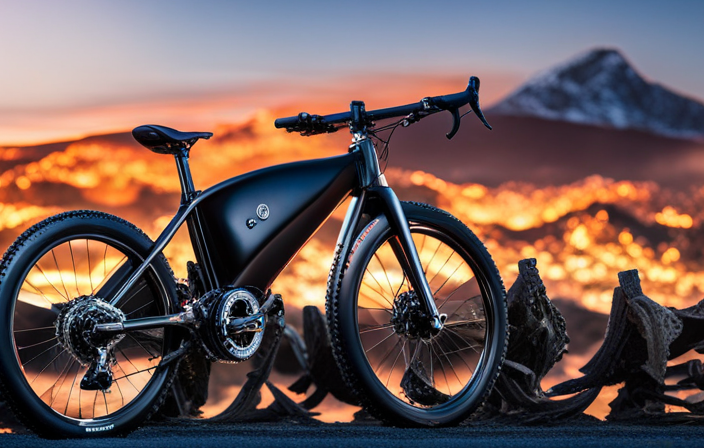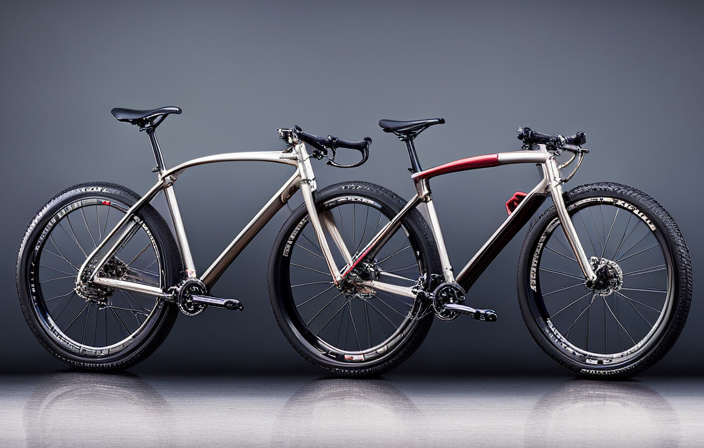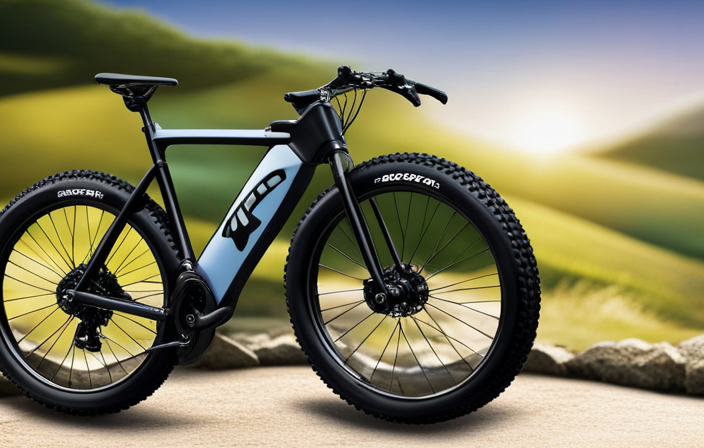Searching for the ideal pedals for your gravel bike can present an overwhelming array of choices, enough to make your head swirl quicker than your cycling. However, have no fear, fellow biking enthusiast! I’ve got your back to illuminate this subject and guide you effortlessly through the complex landscape of pedals.
From flat pedals to clipless pedals, platform pedals to SPD pedals, we’ll explore the pros and cons of each type, ensuring that you find the ideal match for your adventurous rides on those unpaved paths.
So hop on board as we embark on this pedal-powered journey together!
Key Takeaways
- The different types of pedals available for gravel bikes include flat pedals, clipless pedals, platform pedals, and SPD pedals.
- Each type of pedal offers its own set of benefits, such as the stability and ease of use of flat pedals, the efficiency and power transfer of clipless pedals, the versatility of platform pedals, and the convenience and ease of engagement of SPD pedals.
- Some popular pedal brands for gravel bikes include Time Pedals, Shimano Pedals, Speedplay Pedals, and Eggbeater Pedals.
- When choosing pedals for a gravel bike, it is important to consider personal preference, riding style, and specific needs, as well as to properly maintain the pedals for optimal performance.
Flat Pedals
If you’re looking for flat pedals for your gravel bike, you’ll want to consider options that provide a good grip and durability. Flat pedals have become increasingly popular in the gravel biking community due to their numerous advantages.
One major advantage is the ease of use, as they allow riders to quickly put their foot down on uneven terrain or during technical sections. Additionally, flat pedals offer more freedom of movement, enabling riders to easily adjust their foot position while riding.
When it comes to choosing shoes for flat pedals, there are a few recommendations worth considering. Firstly, look for shoes with a sticky rubber sole that provides excellent grip on the pedal surface. The sole should also be stiff enough to transfer power efficiently while pedaling. Popular options include Five Ten Freerider Pro and Specialized 2FO Roost shoes.
Transitioning into the next section about clipless pedals, riders who prefer a secure connection between shoe and pedal may opt for clipless systems. These pedals require special cycling shoes with cleats that attach to the pedal mechanism.
Clipless Pedals
Clipless pedals provide a secure and efficient way for riders to power through rough terrain on their gravel bikes. These pedals, despite their name, actually involve clipping into the pedal using special cycling shoes that have cleats on the soles. Here are some advantages of clipless pedals:
- Enhanced power transfer: By being connected to the pedal, you can apply power throughout the entire pedal stroke, maximizing efficiency.
- Improved control: Being securely attached to the bike allows for better control over technical sections and rough terrain.
- Increased pedaling cadence: Clipless pedals enable a smoother and faster pedaling cadence by eliminating foot slippage.
- Energy conservation: With your feet firmly attached to the pedals, you can use more muscles in your legs and save energy on long rides or climbs.
- Easy disengagement: Contrary to common misconceptions about clipless pedals being difficult to unclip from, modern systems offer quick and easy release when needed.
Transitioning into the subsequent section about platform pedals, it’s important to note that while clipless pedals offer many advantages, they may not be suitable for every rider or every situation.
Platform Pedals
When you’re riding on rough terrain, platform pedals provide a stable and secure surface for your feet. These types of pedals are popular among gravel riders due to their versatility and ease of use. One of the main advantages of platform pedals is that they allow you to ride with any type of footwear, including regular shoes or even hiking boots. This can be a great option if you plan on doing a lot of walking or need to quickly dismount during your rides.
Another advantage is that platform pedals offer a larger surface area for your feet to rest on, providing increased stability and control. This can be especially beneficial when navigating technical sections or when riding in wet conditions. Additionally, platform pedals are generally more affordable compared to clipless pedal systems.
However, there are some cons to consider as well. With platform pedals, you don’t have the benefit of being securely attached to the bike like you do with clipless pedals. This means that your feet may bounce off the pedals on rough terrain or during fast descents. It’s important to develop good technique and maintain proper foot position when using platform pedals.
When choosing the right platform pedals for your gravel bike, consider factors such as weight, grip, and durability. Look for models with adjustable pins that allow you to customize the level of grip based on your preferences and riding conditions.
In conclusion, platform pedals offer several advantages for gravel riders but also come with some limitations. Now let’s move on to discuss another popular pedal option: SPD (Shimano Pedaling Dynamics) pedals…
SPD Pedals
SPD pedals are a popular choice among riders due to their secure attachment and efficient power transfer. These pedals, specifically designed for gravel bikes, offer several advantages that make them a top pick for many cyclists.
One of the key benefits of using SPD pedals is their ability to provide a strong connection between your foot and the pedal. This ensures that your feet stay in place even on rough terrains, giving you better control over your bike. Additionally, SPD pedals allow for efficient power transfer from your legs to the bike, enabling you to generate more speed and climb hills with ease.
Another advantage of using SPD pedals is their versatility. They feature a two-sided design with a cleat mechanism on one side and a flat platform on the other. This means that you can choose whether to use cycling shoes with cleats or regular shoes depending on your preference or the terrain you’re riding on.
Transitioning into the subsequent section about crankbrothers pedals, it’s important to consider all options before making a decision on which type of pedal is best suited for your needs and riding style.
Crankbrothers Pedals
Crankbrothers pedals are known for their unique design and innovative features. When it comes to gravel riding, Crankbrothers offers a range of pedals that are specifically designed to meet the demands of off-road conditions. These pedals provide numerous benefits that make them ideal for gravel biking.
One of the key benefits of using Crankbrothers pedals in off-road conditions is their exceptional mud-shedding capabilities. Gravel riding often involves encountering muddy trails, and these pedals ensure that mud does not clog up the cleats or affect your performance. This feature allows for smooth engagement and disengagement, even in the messiest terrain.
Furthermore, Crankbrothers pedals offer a wide platform which provides excellent stability and power transfer. This is particularly important when tackling uneven surfaces and technical sections during gravel rides. The large contact area between the shoe and pedal maximizes efficiency, allowing you to put down more power with each pedal stroke.
In addition, Crankbrothers pedals are lightweight yet durable, making them suitable for long rides on rough terrains without compromising strength or reliability.
Transitioning into the subsequent section about ‘look pedals’, it’s worth exploring another popular option for gravel biking.
Look Pedals
If you’re looking for another option for your off-road adventures, you might want to consider trying out Look pedals. These clipless pedals offer a range of benefits for gravel riding.
Let’s start with the pros and cons of using clipless pedals. One major advantage is the increased power transfer from your legs to the bike, allowing you to generate more speed and efficiency on rough terrain. Clipless pedals also provide a secure connection between your shoes and the pedal, preventing any accidental slips or disengagement. However, it’s important to note that they do require some practice and getting used to, as clipping in and out can be challenging at first.
On the other hand, if you prefer a different approach, flat pedals also have their advantages for gravel riding. They offer a sense of freedom and allow for quick foot adjustments on technical sections or when maneuvering through obstacles. Flat pedals are also easy to use, requiring no special shoes or cleats.
In conclusion, Look pedals are an excellent choice if you’re seeking enhanced power transfer and security during your gravel rides. However, if you prefer the freedom and simplicity of flat pedals, they are also a great option.
Now let’s move on to discussing Time pedals without missing a beat!
Time Pedals
When considering your options for off-road riding, you might want to try out Time pedals for their unique features and benefits. Time pedals are known for their exceptional durability and reliability, making them a popular choice among gravel bikers.
Here are some pros and cons of using Time pedals:
- Easy engagement: Time pedals have a reputation for being easy to clip in and out of, which can be especially useful when navigating challenging terrain.
- Adjustable tension: These pedals allow you to adjust the tension according to your preference, providing a customizable riding experience.
- Large platform: With a larger surface area compared to other pedal brands, Time pedals offer enhanced stability and power transfer.
- Dual-sided entry: Most Time pedal models feature dual-sided entry, making it effortless to engage with the pedal from either side.
- Lightweight construction: Time pedals are designed with lightweight materials without compromising strength or performance.
To choose the right Time pedals for your gravel bike, consider factors such as your riding style, budget, and personal preferences. It’s also essential to ensure compatibility with your cycling shoes.
Transitioning into the subsequent section about Shimano pedals…
Now let’s explore another popular option for gravel biking – Shimano pedals.
Shimano Pedals
Shimano pedals offer a wide range of options for off-road riding enthusiasts. When it comes to gravel biking, these pedals provide excellent performance and durability. One important aspect of using Shimano pedals on your gravel bike is proper maintenance. Regularly cleaning and lubricating the pedal mechanism will ensure smooth operation and prevent any issues from arising. Additionally, checking the cleats for wear and replacing them when necessary is crucial to maintain optimal power transfer.
Choosing the right Shimano pedal for your gravel bike depends on your specific needs and preferences. The SPD (Shimano Pedaling Dynamics) system is popular among gravel riders due to its reliable engagement and easy release, making it suitable for both on- and off-road conditions. However, if you prefer a larger platform for more stability during rough terrains, Shimano’s XT or XTR trail pedals might be a better choice.
Transitioning into the subsequent section about Speedplay pedals, it’s worth noting that while Shimano pedals are a fantastic option for gravel bikes, some riders prefer different pedal systems like Speedplay due to their unique features or personal preferences.
Speedplay Pedals
After discussing Shimano pedals, let’s move on to another popular option for gravel bike enthusiasts: Speedplay pedals.
These pedals are known for their lightweight design and excellent power transfer, making them a great choice for riders looking to maximize their gravel bike performance.
Speedplay pedals utilize a unique dual-sided entry system, allowing for easy engagement from either side of the pedal. This feature is especially advantageous when riding off-road conditions where quick and efficient engagement is crucial. Additionally, Speedplay pedals offer adjustable float, which allows your feet to move naturally while pedaling, reducing strain on your joints and improving overall comfort.
One notable aspect of Speedplay pedals is their low stack height, which means that the distance between your foot and the pedal spindle is minimal. This low profile design results in improved stability and better power transfer during hard efforts or technical sections.
Overall, if you’re looking to enhance your gravel bike’s performance with a lightweight and efficient pedal system, Speedplay pedals are an excellent choice.
Now, let’s delve into another popular pedal option for gravel bikes: eggbeater pedals…
Eggbeater Pedals
If you want a pedal system that offers lightweight design and easy engagement, the eggbeater pedals are worth considering. These pedals have been popular among gravel bike riders for their unique design and functionality.
One of the major advantages of eggbeater pedals is their weight. They are incredibly lightweight compared to other pedal systems on the market, which can make a noticeable difference in overall bike weight and performance.
Another advantage of eggbeater pedals is their easy engagement. With a simple twist of your foot, you can quickly clip in and out of these pedals, making them ideal for off-road riding where quick disengagement may be necessary. This feature also makes them suitable for beginners who are still getting used to clipping into pedal systems.
However, it’s important to note that there are some disadvantages to using eggbeater pedals as well. One common complaint is that they have a smaller contact area with the shoe, which can lead to hot spots or discomfort during longer rides. Additionally, some riders find that the four-sided entry system of the eggbeaters requires more precision when clipping in compared to other pedal systems.
Transitioning into the subsequent section about ‘float pedals’, it’s interesting to explore another option available for gravel bikers seeking comfort and efficiency on long rides.
Float Pedals
In my last discussion about Eggbeater pedals, I talked about their lightweight design and efficient power transfer. Now let’s shift our focus to another popular option for gravel bike pedals: float pedals.
Float pedals are designed to allow your feet to move laterally while clipped in, providing a small amount of side-to-side movement. This movement is known as ‘float,’ and it can help alleviate knee strain by allowing your joints to move more naturally throughout the pedal stroke.
One of the key benefits of using float pedals is the reduced risk of developing overuse injuries such as patellofemoral pain syndrome or iliotibial band friction syndrome. By allowing your feet some freedom of movement, these pedals can help minimize stress on specific areas of your lower body.
Additionally, float pedals can also offer a more comfortable riding experience. They provide a bit of wiggle room if you prefer shifting your foot position during long rides or if you have any pre-existing foot alignment issues.
Now that we’ve discussed the benefits of using float pedals, let’s dive into another type of pedal that excels in providing excellent traction on rough terrain: traction pedals…
Traction Pedals
Let’s now explore how traction pedals excel in providing excellent grip on rough terrain. When it comes to gravel riding, having the right pedal can make a world of difference in your overall experience. Traction pedals, also known as grip pedals, are specifically designed to provide maximum traction and stability on uneven surfaces.
One of the main advantages of traction pedals is their ability to keep your feet securely planted on the pedals, even when you encounter bumpy or slippery conditions. They typically feature a larger platform with aggressive pins or spikes that dig into your shoe soles, creating a secure connection between your feet and the pedal. This ensures that your feet stay firmly in place, allowing you to maintain control and power throughout your ride.
Choosing the right pedal for gravel riding largely depends on personal preference and riding style. Some riders prefer a more aggressive tread pattern with longer pins for ultimate grip, while others may opt for a less aggressive option that still provides adequate traction without being too harsh on their shoes.
Now let’s move onto the next section about lightweight pedals and how they can enhance your gravel riding experience.
Lightweight Pedals
To enhance your experience when riding on rough terrain, consider opting for lightweight pedals that can provide improved maneuverability and agility. Lightweight pedals offer several benefits for gravel biking.
First, they reduce the overall weight of your bike, making it easier to navigate through challenging terrains. This is especially important during long rides or races where every ounce counts. Additionally, lightweight pedals help you maintain better control over your bike as you can quickly and effortlessly adjust your foot position when needed. They also allow for quicker acceleration and deceleration, allowing you to respond faster to obstacles on the trail.
When choosing lightweight pedals for your gravel bike, there are a few factors to consider. Look for pedals made from durable materials such as aluminum or carbon fiber that can withstand the demands of off-road riding while still being lightweight. It’s also essential to find pedals with a secure grip that will keep your feet in place even on bumpy trails.
In conclusion, opting for lightweight pedals on your gravel bike can greatly enhance your riding experience by improving maneuverability and agility. By choosing the right lightweight pedals that offer durability and grip, you’ll be able to tackle rough terrains with ease.
Transitioning into the subsequent section about ‘adjustable tension pedals,’ let’s now explore another type of pedal that provides added versatility and customization options.
Adjustable Tension Pedals
Consider opting for adjustable tension pedals to add versatility and customization options to your riding experience. Adjustable tension pedals allow you to fine-tune the amount of force required to release your foot from the pedal, providing a secure connection without compromising on ease of use.
One of the main benefits of these pedals is that they cater to different skill levels and preferences. For beginners or those who prefer an easy release, you can set the tension at a lower level, allowing for quick and effortless disengagement. On the other hand, more experienced riders or those who desire a firmer connection can increase the tension for added stability and power transfer.
When it comes to choosing adjustable tension pedals, there are several reputable brands in the market. Shimano offers a range of options such as their SPD-SL line which features adjustable cleat tension for road cycling enthusiasts. Look Cycle’s Keo Blade Carbon pedals also provide adjustable spring tension settings, ensuring optimal performance for competitive riders.
By investing in adjustable tension pedals, you can enhance your cycling experience by tailoring the release mechanism according to your specific needs.
Now let’s explore another type of pedal that offers even more convenience: dual-sided pedals…
Dual-Sided Pedals
If you want a convenient and versatile option for your rides, dual-sided pedals offer the ease of use and flexibility you’re looking for. These pedals feature a platform on one side and a clipless mechanism on the other, allowing you to choose between using regular shoes or cycling shoes with cleats. This is particularly beneficial for gravel riding, as it provides the ability to quickly switch between different types of footwear based on the terrain or personal preference.
There are several benefits of using dual-sided pedals for your gravel bike. Firstly, they provide an increased level of efficiency and power transfer when clipped in. This allows you to generate more force while pedaling, resulting in improved speed and performance. Secondly, these pedals offer a sense of security and stability when riding off-road. The clipless mechanism keeps your feet firmly attached to the pedals, preventing any accidental slips or disconnections.
When choosing the right dual-sided pedals for your gravel bike, there are a few factors to consider. Firstly, make sure that the pedal system is compatible with your cycling shoes or that it comes with suitable cleats. Additionally, consider the weight and durability of the pedals as this can impact their overall performance and longevity.
| Dual-Sided Pedals | |
|---|---|
| 1 | Convenient |
| 2 | Versatile |
| 3 | Efficient |
| 4 | Secure |
| 5 | Compatible |
By selecting dual-sided pedals that meet your specific needs and preferences, you can enhance your gravel riding experience by enjoying the benefits they provide.
Frequently Asked Questions
What are the advantages of using clipless pedals over flat pedals for gravel biking?
There are several advantages to using clipless pedals over flat pedals for gravel biking.
First, clipless pedals provide a more efficient power transfer, allowing you to pedal with greater efficiency and speed.
Additionally, they offer better control and stability, especially when navigating rough terrain or during technical maneuvers.
Clipless pedals also help reduce foot fatigue by providing a secure connection between your feet and the bike.
Overall, they enhance your performance and make gravel biking a more enjoyable experience.
On the other hand, flat pedals have their own benefits for gravel biking.
These include ease of use, freedom of movement, and the ability to quickly put your foot down if needed.
Are there any specific pedals that offer better traction on rough gravel terrain?
When it comes to finding the best pedal brands for gravel biking, there are a few options that offer excellent traction on rough gravel terrain. Some popular choices include Shimano, Crankbrothers, and Time.
To choose the right pedal size for your gravel bike, it’s important to consider factors such as foot size and shoe compatibility. Look for pedals with a wide platform and adjustable pins to provide maximum grip and stability while riding on challenging surfaces.
What are the key features to look for when choosing lightweight pedals for a gravel bike?
When choosing lightweight pedals for a gravel bike, it’s essential to consider key features that enhance your riding experience.
One interesting statistic is that clipless pedals are favored by many professional gravel racers, as they provide better power transfer and efficiency.
However, flat pedals have their advantages too, offering more freedom of movement and easier foot placement on technical terrain.
Ultimately, the decision between clipless and flat pedals comes down to personal preference and the type of riding you do.
Can you explain the concept of adjustable tension pedals and how they differ from regular pedals?
Adjustable tension pedals are a type of pedal that allows you to adjust the amount of force required to release your foot from the pedal. This feature is particularly useful for riders who want more control and security, as it allows them to customize the tension based on their preferences.
Regular pedals, on the other hand, do not have this adjustable feature. When it comes to gravel biking, adjustable tension pedals can provide better traction on uneven terrain, ensuring a more stable and efficient ride.
Other types of gravel bike pedals include lightweight clipless pedals that offer the benefits of increased power transfer and efficiency, as well as dual-sided pedals that allow you to clip in from either side.
Adjusting pedal tension is simple with most models; you can typically use an Allen wrench or similar tool to make adjustments according to your needs.
Are there any dual-sided pedals available for gravel biking, and what benefits do they offer compared to single-sided pedals?
When it comes to gravel biking, dual-sided pedals are a game-changer. These innovative pedals offer the convenience of being able to clip in from either side, making them perfect for quick and easy engagement on unpredictable terrain.
The benefits of dual-sided pedals go beyond just their versatility. They provide improved stability and control, allowing riders to confidently navigate rough trails without worrying about slipping or struggling to find the right position.
So if you’re looking for an upgrade for your gravel bike, dual-sided pedals are definitely worth considering.
Conclusion
In conclusion, when it comes to choosing pedals for your gravel bike, there are several options available.
From flat pedals to clipless pedals, each type offers its own advantages and disadvantages.
Some riders may argue that clipless pedals provide a more efficient power transfer, but it’s important to consider personal preference and riding style.
Ultimately, the best pedal choice will depend on your individual needs and preferences as a rider.
So don’t be afraid to try out different types of pedals until you find the one that suits you best!
